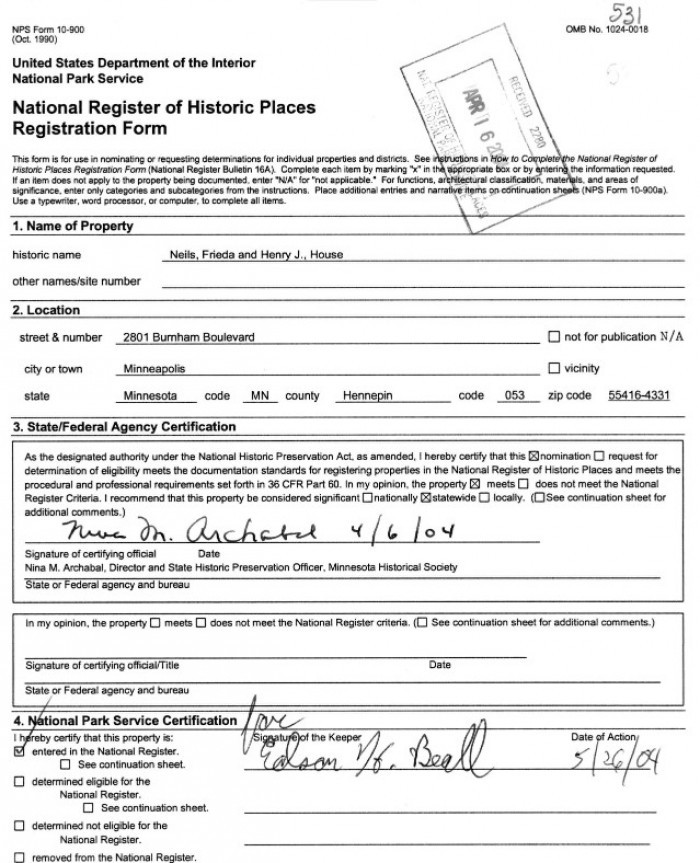How to register your home on the National Register of Historic Places
Exploring the National Register of Historic Properties, a comprehensive list of significant sites, buildings, structures, and districts throughout the United States that possess historical, architectural, or cultural significance.
June 24, 2023
The Hubbard House in Mankota, MN was listed on the National Register of Historic Places in 1975
The National Register of Historic Properties is a prestigious and comprehensive listing of significant sites, buildings, structures, and districts throughout the United States that possess historical, architectural, or cultural significance.
Established by the National Historic Preservation Act of 1966, the National Register serves as the nation's official inventory of historic places worthy of preservation. The National Register is maintained by the National Park Service (NPS), a federal agency within the Department of the Interior. Its primary purpose is to recognize and protect the diverse range of places that contribute to our nation's heritage and collective memory.
Current Criteria for Listing on the National Register of Historic Places:
To be eligible for listing on the National Register, a property must meet specific criteria outlined by the NPS. These criteria include demonstrating historical significance, architectural integrity, and significance within a particular context, such as local or regional history. Properties can be listed individually or as part of a historic district, which consists of a cohesive collection of structures that together create a distinct sense of time and place.
Process of Listing on the National Register of Historic Places
:
The process of listing a property on the National Register involves extensive research, documentation, and evaluation. It typically begins with the property owner or interested parties initiating the nomination process through their State Historic Preservation Office (SHPO). The SHPO reviews the nomination, conducts evaluations, and forwards it to the State Review Board for further assessment. Finally, the National Park Service makes the final determination on the listing.
The National Register of Historic Properties plays a crucial role in preserving and recognizing our nation's rich cultural and architectural heritage. By identifying, protecting, and promoting historically significant places, the National Register ensures that future generations can appreciate and learn from the diverse stories embedded within our built environment.
Importance and Benefits of Registering Your Home
Registering your home on the National Register of Historic Properties or a similar local or regional historic register offers numerous advantages and contributes to the preservation and appreciation of our shared cultural heritage. Here are some of the key importance and benefits of registering your home:
Historical Significance: Registering your home acknowledges its historical importance and recognizes its contribution to the broader historical narrative. It showcases the significance of your home in local, regional, or national history, providing a tangible link to the past.
Preservation: Registering your home promotes its preservation and safeguards its historical integrity. It encourages responsible stewardship, ensuring that future generations can experience and appreciate the architectural, cultural, and historical aspects of the property.
Community Identity: Registered historic homes contribute to the identity and character of a community. They serve as tangible reminders of the community's history and heritage, fostering a sense of place and community pride.
Educational Resource: Registered homes can serve as educational resources for researchers, historians, and the general public. They offer opportunities for learning about architectural styles, historical events, and notable individuals associated with the property. By sharing the stories embedded within the home, you contribute to the collective knowledge of your community.
Economic Benefits: Registering your home can have positive economic impacts. Historic properties often attract tourists, history enthusiasts, and heritage-minded individuals, which can boost local tourism and contribute to the local economy. Additionally, some jurisdictions offer financial incentives, tax credits, or grant programs specifically for historic property owners, providing financial support for maintenance and restoration projects.
Sense of Achievement: Registering your home is an accomplishment in itself. It signifies that your property has met specific criteria for historical and architectural significance, and its registration reflects your commitment to preserving and celebrating the past.
Networking and Support: Registering your home connects you with a network of fellow preservationists, historic property owners, and local preservation organizations. These connections can provide valuable support, advice, and resources for maintaining and restoring your home. Collaboration within the preservation community can enhance your understanding of preservation techniques, best practices, and available resources.
Long-Term Value: Registering your home can enhance its long-term value. Historic properties often enjoy increased desirability in the real estate market due to their unique character, historical significance, and potential financial incentives. Registering your home helps protect its value by ensuring its preservation and preventing inappropriate alterations or demolitions.
Civic Engagement: Registering your home demonstrates your commitment to civic engagement and the preservation of cultural heritage. By actively participating in the preservation process, you contribute to the collective effort of safeguarding our built environment and fostering a sense of pride and appreciation for our shared history.
Registering your home on a historic register provides a range of importance and benefits. It acknowledges the historical significance of your property, promotes its preservation, contributes to community identity, offers educational resources, and may provide economic incentives. By registering your home, you become part of a larger preservation community, contributing to the preservation and celebration of our collective cultural heritage.
Research and Documentation for the National Register of Historic Properties
Research and documentation play a crucial role in the process of registering property on the National Register of Historic Properties. Thorough research and accurate documentation provide the foundation for demonstrating the historical significance and architectural integrity of a property. Here are the key aspects to consider when conducting research and preparing documentation:
Gathering Home History Information
Historical Documents: Collect relevant historical documents such as deeds, photographs, maps, newspaper articles, and personal papers associated with the property. These documents can offer insights into the property's history, ownership, and any significant events.

Oral Histories: Conduct interviews with previous owners, residents, or community members who have knowledge of the property's history. Their firsthand accounts can provide valuable details and anecdotes that might not be found in written records.
Architectural Plans and Drawings: If available, obtain architectural plans, drawings, or blueprints of the property. These can help identify the original design, architectural features, and alterations over time.
Historical Property Research
Contextualize the Property: Place the property within its historical and cultural context. Research the development of the area, significant historical events, and prominent individuals associated with the property or the neighborhood.
Architectural Analysis: Study the architectural style, features, and construction techniques of the property. Identify any distinctive architectural elements that contribute to its historical significance.
Local Historical Records and Archives: Explore local historical societies, libraries, archives, and governmental agencies to uncover additional information about the property's history. This includes examining local newspapers, city directories, tax records, and building permits.
Comprehensive House History and Property Research Documentation Package
Historical Narrative: Develop a detailed historical narrative or statement of significance for the property. This narrative should present a compelling argument for the property's historical importance, highlighting its historical context, notable events, and architectural significance.
Photographs: Capture high-quality photographs of the property's exterior, interior, and significant architectural details. Ensure that the photographs clearly document the property's condition and illustrate its historical and architectural significance.
Architectural Descriptions: Provide detailed descriptions of the property's architectural features, materials, and design elements. Include floor plans, if available, and describe any changes or alterations that have occurred over time.
Supporting Documents: Include any additional supporting documents that strengthen the case for the property's historical significance. This may include newspaper clippings, letters, maps, or other relevant materials.
It is important to note that specific requirements and guidelines for research and documentation may vary between different state historic preservation offices or local preservation organizations. It is advisable to consult with the relevant authorities or seek assistance from local preservation professionals to ensure compliance with the specific registration process and documentation standards.
Thorough research and accurate documentation are critical to demonstrating the historical and architectural significance of a property. They provide the basis for evaluating a property's eligibility for the National Register of Historic Properties and serve as a lasting record of its historical value.
Seeking Help from Local Preservation Organizations for National Register Application
When applying to register your property on the National Register of Historic Properties, seeking assistance and guidance from local preservation organizations can be immensely beneficial. These organizations are dedicated to the preservation and promotion of historical properties and possess expertise in navigating the application process. Here's why reaching out to local preservation organizations is advantageous:
Expert Knowledge and Experience: Local preservation organizations often have a wealth of knowledge and experience in the field of historic preservation. They understand the intricacies of the application process, including research, documentation requirements, and evaluation criteria. Their expertise can help streamline the application process and increase the chances of a successful nomination.
Guidance on Eligibility: Local preservation organizations can assess the eligibility of your property for listing on the National Register. They can provide insights into the specific criteria and standards used by the National Park Service and the State Historic Preservation Office (SHPO). Their expertise can help determine if your property meets the necessary requirements for inclusion.
Assistance with Research and Documentation: Researching and documenting the historical significance of a property can be a complex task. Preservation organizations can guide you through the research process, helping you identify relevant resources, locate historical documents, and conduct oral history interviews. They can also provide advice on creating a comprehensive documentation package, including historical narratives, architectural descriptions, and photographs.
Collaboration and Networking: Local preservation organizations offer opportunities for collaboration and networking with other property owners, professionals, and preservation enthusiasts. Engaging with these networks can provide valuable insights, advice, and support throughout the application process. By connecting with like-minded individuals, you can learn from their experiences, share resources, and build a strong preservation community.
Access to Funding and Resources: Local preservation organizations often have knowledge of funding opportunities, grants, and resources available for historic property owners. They can help you identify potential sources of financial assistance for preservation projects or provide information on workshops, training, and educational programs related to historic preservation.
Advocacy and Support: Preservation organizations are dedicated to advocating for the preservation of historic properties. They can support you in advocating for the significance of your property, raise awareness about its historical importance, and promote its inclusion on the National Register. Their expertise in public engagement and advocacy can be invaluable in garnering community support for your application.
To seek help from local preservation organizations, start by researching and identifying organizations in your area. Local historical societies, preservation commissions, heritage organizations, or statewide preservation nonprofits are potential resources to consider. Reach out to them, express your interest in registering your property, and inquire about their services and assistance for National Register applications.
Remember that each organization may have its own processes, requirements, and areas of focus. Be prepared to provide them with relevant information about your property, such as its history, architectural details, and current condition. Collaborating with local preservation organizations can greatly enhance your application and increase the chances of successfully listing your property on the National Register of Historic Properties.
National Register of Historic Places Nomination Process
The National Register nomination process is a comprehensive and structured procedure that involves several steps and requires careful attention to detail. The process is overseen by the State Historic Preservation Office (SHPO) and the National Park Service (NPS). Here is an overview of the National Register nomination process:
Consult the State Historic Preservation Office (SHPO)
Contact the SHPO in your state to inquire about the National Register nomination process and express your interest in registering your property.
The SHPO can provide guidance on the specific requirements, documentation, and deadlines for submitting a nomination.
Obtain and Complete the Nomination Form
Request the nomination form from the SHPO or download it from their website. The nomination form requires detailed information about the property, including its history, architectural features, and significance. Fill out the form accurately, providing all requested information to the best of your knowledge.

Prepare Supporting Documentation
Develop a historical narrative or statement of significance that explains the historical and architectural importance of the property. Include high-quality photographs of the property's exterior, interior, and significant architectural details. Provide detailed architectural descriptions, floor plans (if available), and any other relevant supporting documents.
Submit the Nomination Package to the SHPO
Follow the submission instructions provided by the SHPO, which may include specific formatting requirements or additional forms. Include any required fees, if applicable, along with the nomination package. Keep copies of all submitted materials for your records.
SHPO Review and Consultation
The SHPO reviews the nomination package for completeness and accuracy. They may request additional information or clarification if needed. The SHPO provides guidance and feedback on the nomination, ensuring that it meets the necessary standards and criteria.
State Review Board Evaluation
The nomination is presented to the State Review Board for evaluation. The board consists of professionals in the fields of history, architecture, archaeology, and related disciplines.
The board assesses the property's significance and evaluates whether it meets the criteria for National Register listing.
Determination by the National Park Service (NPS)
The SHPO and State Review Board's evaluations and recommendations are forwarded to the National Park Service for final determination. The NPS reviews the nomination and supporting materials, considering the property's historical, architectural, and cultural significance. The NPS makes the final decision on whether to list the property on the National Register. It is important to note that the National Register nomination process can vary slightly between states and localities. Therefore, it is advisable to consult the specific guidelines and requirements provided by your state's SHPO.
The National Register nomination process requires careful research, thorough documentation, and adherence to the established criteria and guidelines. By following the process diligently and seeking guidance from the SHPO, you can increase the chances of successfully registering your property on the National Register of Historic Properties.
Review and Evaluation for the National Register
The review and evaluation process is a critical step in the National Register of Historic Properties nomination process. It involves the assessment of the property's historical, architectural, and cultural significance by various entities, including the State Historic Preservation Office (SHPO), the State Review Board, and the National Park Service (NPS). Here is an overview of the review and evaluation process:
SHPO Review
After submitting the nomination package, the SHPO conducts a comprehensive review of the materials.
The SHPO verifies the accuracy and completeness of the nomination, ensuring that all required information and supporting documentation are provided.
They may request additional information, clarifications, or revisions to the nomination if necessary.
State Review Board Evaluation
Once the SHPO completes its review, the nomination package is presented to the State Review Board. The State Review Board typically consists of professionals in the fields of history, architecture, archaeology, and related disciplines. The board evaluates the property based on its historical and architectural significance, using established criteria and guidelines. They assess the property's integrity, historical context, associations with significant events or individuals, and its contribution to the understanding of local, regional, or national history.
Consultation and Public Input
Throughout the review process, there may be opportunities for consultation and public input. The SHPO or State Review Board may seek expert opinions, conduct site visits, or engage with the property owner, local community members, or interested stakeholders. Public comments and feedback may be solicited to gather additional information or perspectives regarding the property's significance and potential impact of a listing.
National Park Service (NPS) Determination:
Following the review and evaluation by the SHPO and State Review Board, the nomination package, along with their recommendations, is forwarded to the NPS. The NPS carefully evaluates the nomination, considering the property's historical, architectural, and cultural significance within a national context. The NPS assesses whether the property meets the National Register's criteria for listing, which include demonstrating historical significance, integrity, and significance within a particular context. The NPS makes the final determination on whether to list the property on the National Register.
Notification of Listing
If the property meets the criteria and is approved for listing, the NPS notifies the property owner and the SHPO. The property is officially listed on the National Register of Historic Properties, recognizing its historical and architectural significance. It's important to note that the review and evaluation process may take several months or longer, depending on the specific state or region and the workload of the reviewing entities. It requires patience, thoroughness in providing documentation, and collaboration with the SHPO and other involved parties.
The review and evaluation process ensures that properties listed on the National Register meet the required standards of historical and architectural significance. It is designed to maintain the integrity and credibility of the National Register and ensure the recognition and preservation of our nation's valuable historic resources.
Post-Listing Considerations for the National Register
Once a property is listed on the National Register of Historic Properties, there are several post-listing considerations that property owners should be aware of. These considerations involve ongoing stewardship, potential benefits, and responsibilities associated with the listing. Here are some key post-listing considerations:
Stewardship and Maintenance: As a property owner, it is essential to continue the stewardship and maintenance of the listed property.
Regular upkeep, preservation of historic features, and addressing maintenance needs are crucial to ensure the long-term preservation of the property's historic character.
Preservation Planning: Develop a preservation plan that outlines specific goals and strategies for the continued care, maintenance, and potential restoration of the property.
The preservation plan can guide future decision-making regarding repairs, alterations, and any proposed changes to the property.
 Access to Preservation Resources: Being listed on the National Register can provide access to preservation resources and expertise.
Access to Preservation Resources: Being listed on the National Register can provide access to preservation resources and expertise.
Explore local, state, and federal programs, grants, and tax incentives that may be available for historic preservation projects. Consult with the State Historic Preservation Office (SHPO) and local preservation organizations for guidance and support.
Tax Incentives and Financial Benefits: Listing on the National Register may make the property eligible for various tax incentives and financial benefits. Investigate potential federal and state tax credit programs that offer incentives for qualified rehabilitation and preservation work on historic properties. Consult with tax professionals or preservation experts to understand and maximize the available financial benefits.
Historic Preservation Easements: Consider placing a historic preservation easement on the property to protect its historic features and prevent inappropriate alterations in the future. Easements are legal agreements that restrict certain activities or changes to the property, ensuring its long-term preservation and historic integrity.
Public Awareness and Education: Embrace the opportunity to share the property's history and significance with the public.
Participate in local events, heritage tourism initiatives, or educational programs to raise awareness about the property's importance and contribute to the community's understanding of local history.
Collaborate with Preservation Organizations: Engage with local preservation organizations, historical societies, or heritage groups to access networking opportunities and expertise. Collaborate with these organizations to promote the property, share knowledge, and contribute to the preservation of other historic resources in the community.
Ongoing Evaluation: Periodically reassess the property's condition, preservation needs, and potential threats. Regularly review the preservation plan and make adjustments as necessary to ensure the property's ongoing preservation and compliance with any applicable preservation standards.
It is important to note that while listing on the National Register recognizes the property's historical significance, it does not impose restrictions on the property's use or prevent alterations. However, local preservation ordinances or historic district regulations may apply in some cases, and it is essential to understand and comply with those requirements.
By engaging in responsible stewardship, property owners can continue to preserve and celebrate the historic significance of their listed properties for future generations to appreciate and enjoy.
In conclusion, registering a home on the National Register of Historic Properties involves several important steps. It begins with thorough research and documentation to establish the historical significance and architectural integrity of the property. Seeking assistance from local preservation organizations can provide valuable expertise and support throughout the application process. The nomination package is then submitted to the State Historic Preservation Office, followed by review and evaluation by the State Review Board and the National Park Service. If approved, the property is listed on the National Register, signifying its importance in our cultural heritage.
Preserving and celebrating our cultural heritage holds immense value for both present and future generations. By recognizing and protecting historically significant properties, we ensure the continuation of our shared narratives, architectural legacies, and connections to the past. These properties serve as tangible reminders of our history, illustrating the diverse stories, communities, and innovations that have shaped our society.
Moreover, the benefits of registering a property on the National Register extend beyond personal satisfaction. Property owners gain access to preservation resources, financial incentives, and tax credits that can support the ongoing stewardship and maintenance of their historic properties. Additionally, listing on the National Register fosters community pride and generates opportunities for public education, heritage tourism, and engagement in local preservation efforts.
Preserving and celebrating our cultural heritage is not just about protecting individual buildings; it is about honoring the collective identity and memory of a community. Each registered property represents a piece of our cultural tapestry that enriches our understanding of the past and informs our present. By safeguarding and cherishing our historic properties, we demonstrate a commitment to preserving our shared heritage for future generations to appreciate, learn from, and cherish.
In a rapidly changing world, the National Register of Historic Properties stands as a testament to our commitment to preserving and celebrating the diverse architectural, historical, and cultural treasures that make our communities unique. Let us continue to recognize, protect, and advocate for the preservation of our cultural heritage, ensuring that these significant properties endure as cherished reminders of our collective history.

Not the Up House—But Even Better: Edith Macefield Said No to $1 Million, So They Built a Mall Around Her
You may have heard about the one-bedroom house in Seattle that blocked a mall.

Comprehensive Guide to Architectural Styles: How to Identify Your Home’s Architecture
Not sure if your home is Tudor, Craftsman, or Mid-Century Modern? This comprehensive guide breaks down architectural styles with photos and defining characteristics to help you identify your home’s unique history.

Architectural Innovator: Unveiling the Genius of Raphael Soriano
Step into the world of architectural brilliance as we delve into the legacy of Raphael Soriano, a visionary who redefined the landscape of design.

Simple Steps to Buy an Abandoned Property in the US
According to the Washington Post, approximately 1.5 percent of all residences in the United States are currently vacant even though the majority of housing markets are lacking homes for sale.
